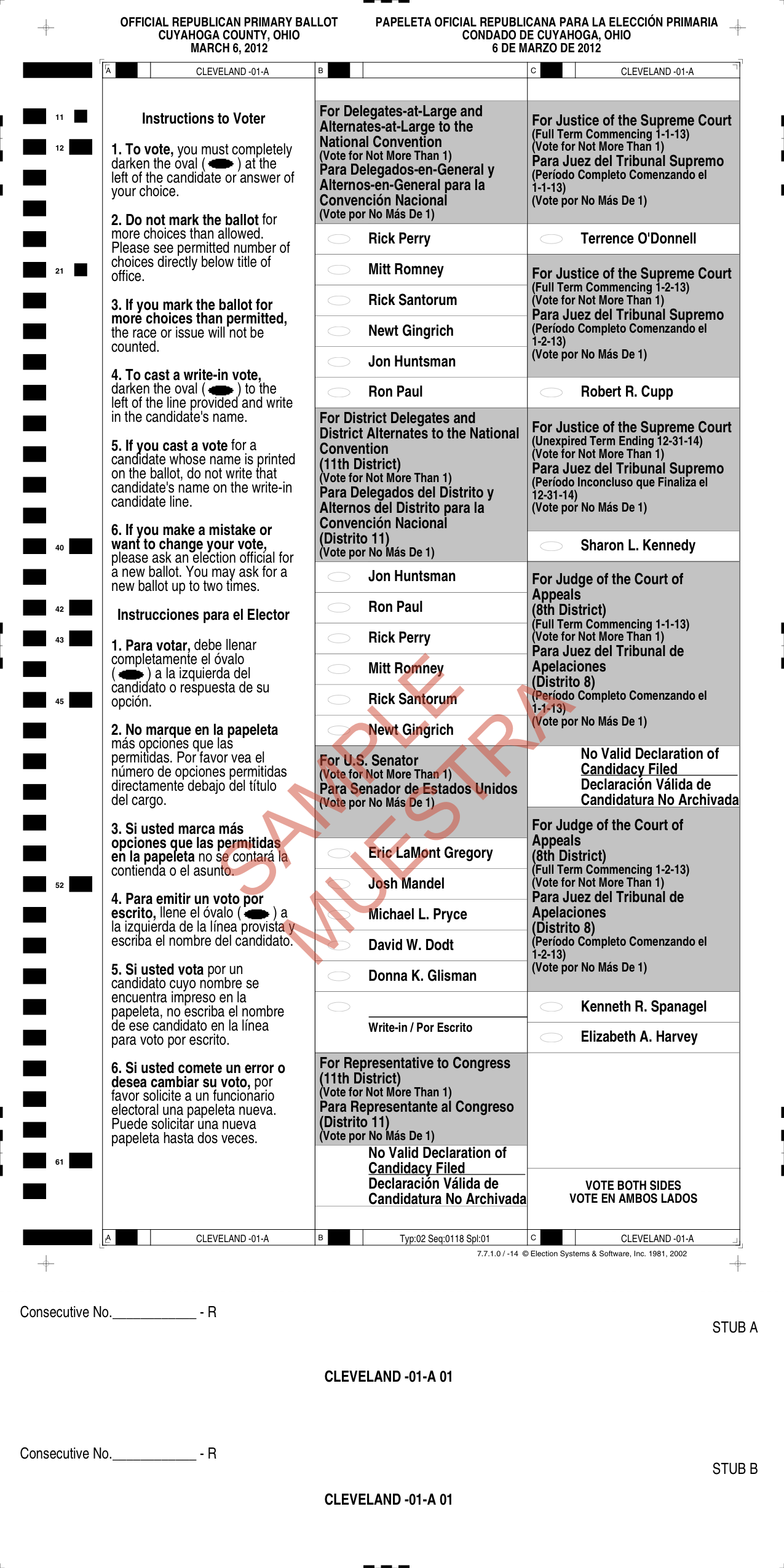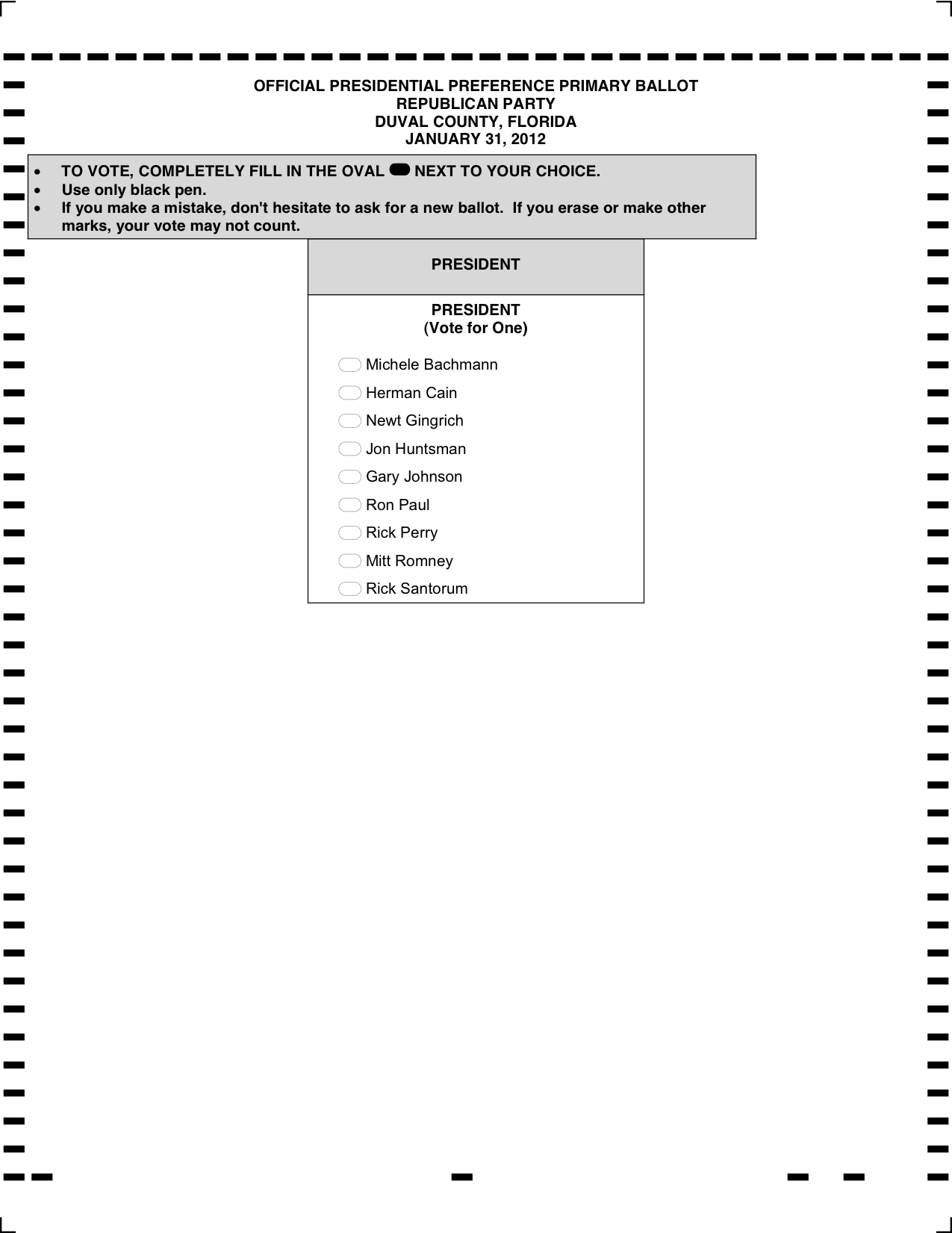Some Florida results by county: http://www.earlyvoting.net/blog
Takeaways: At least in Duval County, Romney showed no substantial early and absentee margin. And Herman Cain got far more election day votes!
Some Florida results by county: http://www.earlyvoting.net/blog
Takeaways: At least in Duval County, Romney showed no substantial early and absentee margin. And Herman Cain got far more election day votes!
Yes, Tuesday is primary Election Day in Florida. On the same day, early in person voting opens in Ohio.
Here is a sample ballot from Cuyahoga. Perry and Huntsman remain on the ballot.

I’ve blogged a few times about the unanticipated infrastructure demands created by early voting. Most elections offices are designed to handle a few hundred citizens with questions about registration or disabled citizens needing use special access machines, not thousands or tens of thousands of voters showing up to cast a ballot. thousands of in-person voters.
This story from Jackson County, MO, just outside of Kansas City, illustrates the problem.
five election dates, new legislative districts thanks to the 2010 census and even seemingly simple things like generating new notification cards for every registered voter. And the November ballot – with a presidential race, several statewide races and initiatives, state legislative contests and possibly local ballot issues – is expected to be long.
The Democratic director of the board, Bob Nichols, noted “We had people lined up outside and in our office.” Tammy Brown, Nichols’s Republican counterpart, added “It is a crazy year.”
Adapt or die, as my colleague Doug Chapin often notes, and in this case, adaptation was easy. The story doesn’t note who saw the empty storefront across the street, but the Board has rented it, and just like that, more space for voting, shorter lines, and less stress on the elections staff.

A little mathematics and some web browsing skills, and it looks like somewhere between 8% and 17% of the ballots in Florida have already been cast.
Keep in mind that, as of today, four candidates (Bachmann, Cain, Huntsman, and Perry) were on these ballots, and three (Bachmann, Huntsman, and Perry) were still actively competing well into the absentee balloting period.
We’ll use Miami Dade County to make our calculations, but this same exercise can be done throughout Florida (and you can bet the Romney, Gingrich, and Santorum forces are making these calculations daily).
Miami Dade County, reports 42,149 absentee ballots returned as of close of business yesterday, totaling 32% of the 130,491 ballots mailed out. The Miami Herald reports 143,000 ballots voted statewide, just over 30% of absentee ballot request.
According to GOP registration for the primary (the county code for Miami is “DAD”), 35% of Republicans requested an absentee ballot.
That gives us the turnout so far, and the percent of registered Republicans who requested an absentee ballot. Now we need to estimate overall turnout. In the 2008 presidential primary, turnout statewide was 38%, and in Miami Dade, turnout among Republicans in the 2008 primary was 40%. Among Republicans in Miami Dade in 2008, 20.8% (33,548) of all ballots were cast absentee (another 24,744 were cast early in person).
Now we have almost all the pieces of our puzzle: registration, percent requesting an absentee ballot, percent voting overall, and percent voting absentee.
But wait! We already have 42,149 absentee ballots returned in Miami-Dade, almost 10,000 more than the 2008 total. What’s going on?
Maybe there are more Republicans? No–according to the state, there are 7000 more GOP registrants in Miami-Dade in 2012 than in 2008. Maybe Republican turnout will be higher? Possibly, although the 2008 primary was still quite competitive on the Republican side.
But what if Republicans are voting absentee at a higher rate than in the past? State party leaders said that absentee ballot requests are double the 2008 rate! The ground has shifted in Florida.
Now the final piece of the puzzle: we need to take into account absentee ballots that are never returned. Charles Stewart, in his recent Election Law Journal article “Adding Up the Costs and Benefits of Vote By Mail” has coined the term “ballot leakage” to describe absentee ballots that are but not counted, either because they are not returned (20% nationwide) or otherwise spoiled. We’ll try to account for “leakage” below.
Let’s do the math:
32% of absentee ballots already returned x 1.25 (assuming only 80% of absentee ballots are actually voted) = 40% of all absentee ballots that will be voted have already been voted.
40% x 20.8% (percent of all ballots in Miami Dade that were absentee in 2008) = 8.32% of the GOP primary vote in Miami Dade has already been cast.
And if the state GOP if correct, and twice as many GOP primary ballots will be cast absentee, then almost 17% of the ballots are already in. That’s an awful lot of votes cast on a ballot containing four names of candidates who are no longer in the race.
http://gao.gov/products/GAO-12-69. From the abstract:
For the 2010 general election, 35 states and the District provided voters at least one alternative to casting their ballot on Election Day through in-person early voting, no-excuse absentee voting, or voting by mail. Specifically, 33 states and the District provided in-person early voting, 29 states and the District provided no-excuse absentee voting, and 2 states provided voting by mail to all or most voters. Of the 9 states and the District where GAO conducted interviews, all but 2 states provided voters the option of in-person early voting in the 2010 general election, and 5 states and the District offered both early voting and no-excuse absentee voting. Implementation and characteristics of in-person early voting varied among the 7 states and, in some cases, among the jurisdictions within a state. For example, 5 states and the District required local jurisdictions to include at least one Saturday, and 2 states allowed for some jurisdiction discretion to include weekend days.
| Florida | 1/31/2012 | 54% |
| Arizona | 2/28/2012 | 53% |
| Michigan | 2/28/2012 | 25% |
| Georgia | 3/6/2012 | 53% |
| Ohio | 3/6/2012 | 30% |
| Tennessee | 3/6/2012 | 60% |
| Vermont | 3/6/2012 | 29% |
| Illinois | 3/20/2012 | 22% |
| Wisconsin | 4/3/2012 | 21% |
| Texas | 4/3/2012 | 66% |
It is surprisingly difficult to predict the percentage of ballots that will come in early, via in-person voting or no-excuse absentee ballots, in the upcoming primaries. Many states have only recently begun to report individual voting histories that include the mode of ballot return, and even if they do have that information, even fewer provide the date.
At least one well-known data aggregator–Catalist--doesn’t capture the date of the ballot return on its permanent database, although that information is collected in real-time during election season.
Florida is a nice example: it does a wonderful job reporting early voting data, including the exact date that the ballot was cast. Individual no-excusse absentee records, however, are only available to registered party committees and candidate organizations.
To make things even more complicated, we know that Republican voters have historically tended to use no-excuse absentee ballots at a much higher rate than Democratic voters.
With all these caveats, the table reports the percentage of ballots that were cast prior to election day in the 2008 general election for selected upcoming states. Any state reporting less than 20% advance voting has been excluded. If you are trying to project backwards, most states now mail their domestic no-excuse ballots 45 days before the date of the election, the same time they are required to mail UOCAVA ballots/
Rick Perry robocalls targeted at absentee balloters: http://bit.ly/AfHP9G
The total number of absentee ballots in Florida exceeds the number of votes cast in NH and caucus goers in IA, and are double 2008 levels. Thus far, 46,000 ballots have been returned: http://thesent.nl/yKaAEn
The time and place of Florida early in person voting: http://election.dos.state.fl.us/pdf/Early_Voting_Sites_PPP_2012.pdf
Page at the FL SoS office explaining the odd legal situation whereby you can obtain early voting reports but not no-excuse absentee reports: https://doe.dos.state.fl.us/fvrscountyballotreports/fvrsefilings.aspx
Yesterday’s posting has generated a lot of email traffic. My personal interest in the study was the finding that online, email, or web-based contact and mobilization methods may not always be more efficient for the voter, or result in higher turnout or vote share.
It’s important to clarify, however, that the “online” voter registration materials being tested were a “print and mail” PDF form created by Rock the Vote, not the same thing as the fully online system being implemented by some states.
As far as I can tell, there is no study to date comparing the take up rate of fully online systems vs. paper systems vs. some hybrid, nor how different contact methods may improve take up of each system.
A new study published in the Political Research Quarterly (may be gated for some readers) by Elizabeth Bennion and David Nickerson is one of many recent articles that suggest that moving some part of voter mobilization activities online may actually reduce participation by raising transactional cost for some citizens. Completing some forms online, it turns out, it not actually easier for many segments of the population and for some activities. As the authors note:
Unfortunately, the savings in communication introduced by Web sites and e-mail do not necessarily make such technologies effective campaign tools. Powerful anecdotal evidence suggests that e-mail can be an effective tool for activities that involve coordinating activists, such as campaign donations or rally attendance, but online communication tools exhibit two chief drawbacks for mass mobilization. First, social norms against sending unsolicited e-mail and the passive nature of Web sites (i.e., viewers need to seek out the Web site) limit the online campaign exposure to politically interested persons and supporters. While a campaign can engage and organize supporters very efficiently online, the vast majority of people casting a ballot will have no exposure to the online arm of a candidate’s campaign. The second drawback is that e-mail outreach is easy to ignore and has not been effective at increasing voter turnout.
The article in question draws on a large experimental study of registration activities on 26 college campuses, conducted in a partnership with Rock the Vote. The authors show that, while an email encouraging a citizen by itself may have no effect (or possibly a negative effect) on the likelihood of registration, a simple followup email that reminds the recipient to turn in the online form can offset much of the negative impact. In short, the authors write:
Rather than a nice bell or whistle if budget permits, follow-up is required to make online mobilization techniques effective. To the extent that organizations can mimic the hand-holding that occurs in government assistance offices and from volunteers in registration drives, the more effective such tactics will be.